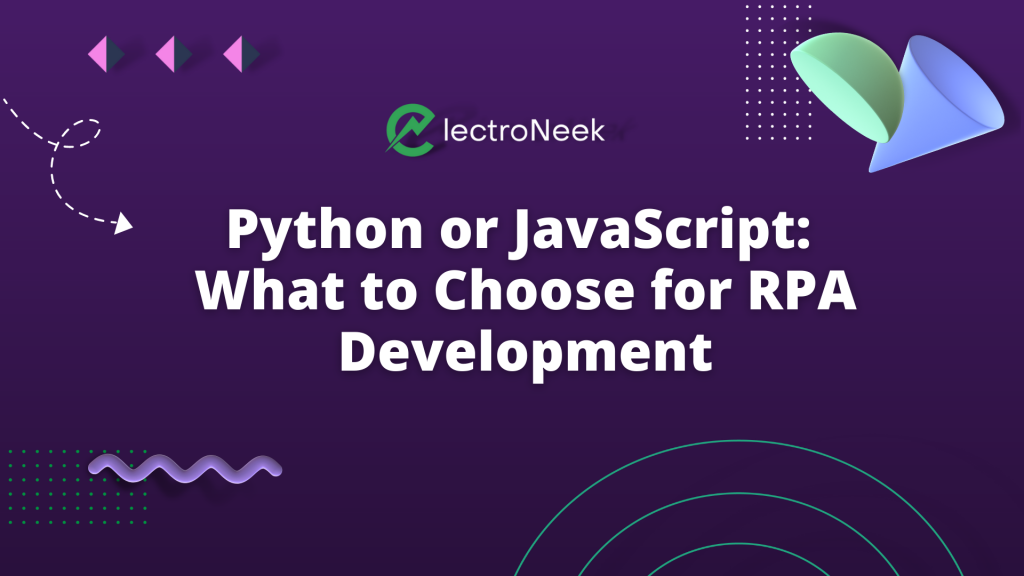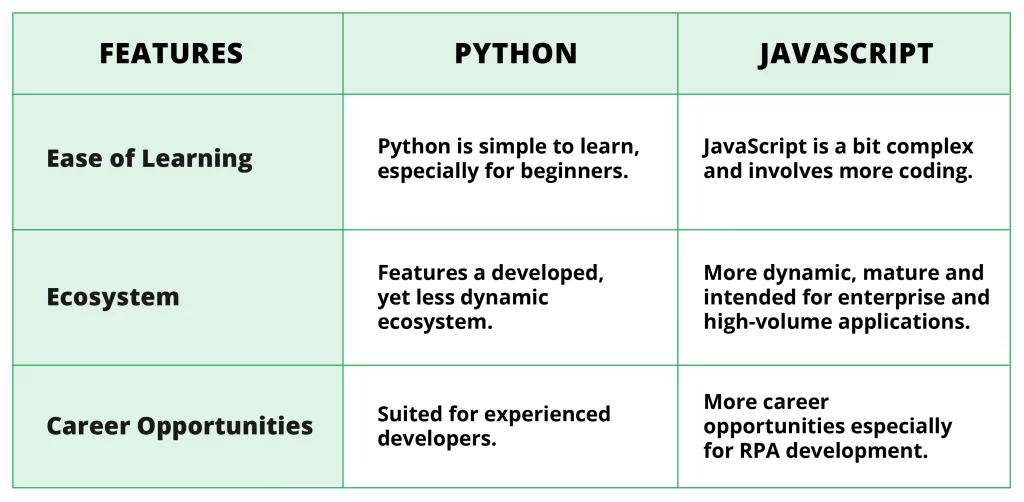
There are dozens of programming languages to explore these days, but Python and JavaScript are among the top contenders. Developers interested in getting into RPA development will find it difficult to choose between the two, especially those who are new to the area of programming. However, they are looking for an answer before even learning anything about Python and JavaScript.
This article will answer this question by providing a basic introduction to both languages, before delving into how Python and JavaScript are typically utilized.
Does RPA require coding?
RPA does not require code development (although coding may be necessary in extreme cases). There is a minimal amount of coding involved in RPA as codes are inbuilt into many RPA tools. While leveraging an RPA tool, all you need to use is a built-in drag editor to create a sensible workflow. The underlying software provides coding.
RPA tools mask the coding behind visual mechanisms, and users are simply clicking and pointing (or dragging and dropping) the code blocks to create process maps, which is why we call them “no-code / low-code” software.
Python
Python is an interpreted high-level, general-purpose programming language, and is considered one of the top five fastest-growing programming languages, according to the 2020 Stack Overflow study. Developers use this open-source language for a variety of applications.
One key benefit of Python is its beginner-friendly nature; whether you are an experienced developer or taking your first steps in programming, you can begin diving into the world of Python. This flexible coding language is used in various areas like application development, software development, data mining, etc.
JavaScript
JavaScript (abbreviated as JS) is the most popular among all programming, scripting, and markup languages globally, and has become one of the three main programming languages for web developers. JavaScript is a high-level dynamic scripting programming language, meaning it is multi-paradigmatic (supports both functional and object-oriented programming). It is often used to create interactive web pages and software applications.
JavaScript is the go-to programming language for browsers, and features compatibility with Windows, Linux, Mac OS operating systems, and all popular mobile devices (iOS/Android/Win).
Python or JavaScript: which is better for RPA development

The IT sector is constantly transforming, and emerging technologies such as Robotic Process Automation (RPA), Artificial Intelligence (AI), the Internet of Things (IoT), and Blockchain will continue to dominate this sector in the near future. Similarly, new programming languages such as Rust and Julia are introduced while the old ones are regularly updated.
Suppose a developer wants to grow their career with RPA skills. In that case, they must decide on which programming language to learn or which language to focus on (if you are an experienced developer).
While the automation from an RPA tool runs at the graphical user interface level, RPA developers must know the underlying programming language of the tool. Why? Because they may need to customize the bots for complex processes using that programming language.
When comparing JavaScript with Python, we will analyze three factors: ease of learning, career opportunities, and ecosystem.
Ease of learning
An important factor in choosing a programming language for RPA is the ease of learning, especially for novice developers. If you are starting your career in the field of RPA programming, you may want to select an easy language and start learning it from scratch.
Python is a beginner-friendly language and uses simple variables and functions, and novice RPA developers can quickly learn its programming concepts without having to dive into complex details off the bat. JavaScript is a bit more complex than Python, and it may be difficult to grasp the concepts of this verbose programming language (JavaScript features more lines of code than Python) as a beginner.
However, JavaScript offers better portability and cross-platform support. Python is slower than JavaScript, and the developers may need to use other libraries written in faster languages such as C++. JavaScript allows developers to complete work faster, and they can write one application and run it on several platforms.
Ecosystem
Both JavaScript and Python have robust libraries and frameworks supported by a large community of developers. However, the JavaScript ecosystem and community are more dynamic and mature than Python.
Additionally, JavaScript’s mature libraries and frameworks are intended for enterprise and high-volume applications. Therefore enterprise application development becomes much easier in JavaScript for RPA developers.
The benefits of such robust communities within a programming language for novice developers include if they do not find a solution to a problem they encountered in JavaScript, they can leverage the experiences and solutions discovered by the community at large. Many possible issues an amateur developer may encounter have been discussed, resolved, and maybe archived in Stack Overflow.
Career opportunities
JavaScript is omnipresent – front end (web browsers), back end (Node, Deno), Android/iOS (React Native, NativeScript, etc.), Desktop (Electron), and Hybrid (Ionic). This programming language satisfies the needs of RPA developers very well in terms of full-stack development. Python is primarily a back-end language suited for data analysis, artificial intelligence, and machine learning.
If you consider starting your career in RPA development, we recommend learning JavaScript, while experienced developers (including RPA developers) should learn Python to write and complete scripts quickly to save time.
Grow Your RPA Developer Skills and Stay Ahead of the Game
In this article, we answered which programming language RPA developers should select as they grow their skills. While there are reasons to choose either JavaScript or Python, we suggest taking a look at your options in terms of growth prospects and income. Both languages are good options, and you should choose one according to your aspirations.
The decision should also be based on your experience (i.e., whether you’re a novice or experienced developer). Research which language is in demand in your country or industry, and decide what path best fits your own career. In any way, learning these programming languages is rewarding and will benefit you no matter the direction you choose.
The boom in RPA interest has generated a lot of hiring activity, and many job-hunting platforms like LinkedIn and Indeed have listed many RPA jobs. As more and more organizations adopt RPA technology, we expect more companies to hire RPA developers with the necessary skill set. If you are considering a change in occupations, reskilling, or starting your career in RPA, it’s high time to select a leading RPA platform such as ElectroNeek to get hands-on proficiency.
ElectroNeek offers in-depth training programs and certifications through its academy with different learning paths to help RPA developers polish their skills. ElectroNeek is also looking to hire trained talent for RPA jobs. You can explore multiple open roles at ElectroNeek’s job board.